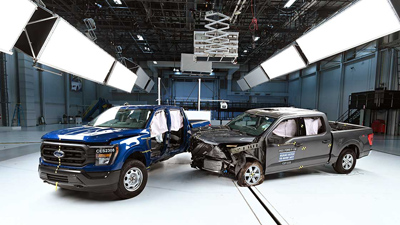Advancements in front seat passenger safety have not yet reached the rear seat of popular full-size pickups.
In a recent safety assessment by the Insurance Institute for Highway Safety (IIHS), four 2023 pickup trucks demonstrated strong protection capabilities in side crashes. However, there's a concerning issue when it comes to safeguarding passengers in the back seat.
The Ram 1500 crew cab, Ford F-150 crew cab and Toyota Tundra crew cab earned good ratings in IIHS's updated side crash test, while the 2023 Chevrolet Silverado 1500 crew cab received an acceptable rating.
"Like most other vehicle classes, large pickups don t perform as well in the new moderate overlap evaluation as they do in the updated side test, which is now a requirement for our TOP SAFETY PICK awards," said IIHS President David Harkey.
This shift in focus is driven by research indicating the risk of fatal injury is higher for belted occupants in the second row than for those in the front.
Harkey explained this discrepancy is not due to a decrease in back seat safety, but rather the significant improvements in front seat safety, including advanced airbags and seat belts. These safety enhancements, while crucial for front-seat passengers, are rarely available in the back, making it essential to address back seat safety separately.
Testing Methodology
In the updated moderate overlap front test, a second dummy is positioned in the second row behind the driver, simulating rear-seat passengers. The IIHS researchers developed new metrics to focus on injuries commonly seen in the back seat.
To earn a good rating, a vehicle must ensure there's no excessive risk of injury to the head, neck, chest or thigh for the rear-seat passenger. The dummy should remain correctly positioned without submarining---sliding forward beneath the lap belt---during the crash. Additionally, the head should maintain a safe distance from the front seatback, and the shoulder belt should remain on the shoulder. These criteria aim to minimize the risk of abdominal injuries. A pressure sensor on the rear dummy's torso ensures proper shoulder belt positioning during the crash.
All four pickup trucks provided good protection for front seat occupants, but their restraint systems in the rear were deemed inadequate. Submarining was a common issue in all four pickups, with belt forces being too high in all except the Tundra.
Specific Vehicle Ratings
In the updated test, the Tundra earned a marginal rating, the highest among the four pickups. The F-150, Ram 1500 and Silverado received poor ratings in this evaluation.
Measurements from the rear dummy indicated that chest injuries and head or neck injuries would be likely in the F-150 and Ram 1500. Although the risk was somewhat lower in the Silverado, it was still considered excessive. The Tundra showed a slightly elevated risk of chest injuries due to poor belt positioning but had a lower risk of head or neck injuries.
Side Crash Ratings
In contrast, the updated side crash test was introduced to address higher-speed crashes that still result in fatalities, even for vehicles that performed well in the original evaluation. The updated test uses two dummies, a driver and a rear passenger, and a heavier barrier traveling at higher speeds to simulate real-world conditions.
In this test, the F-150, Ram 1500 and Tundra earned good ratings, providing solid protection for both front and rear passengers. However, there was a slight compromise in the occupant compartment of the F-150 due to the impact. The Silverado received an acceptable rating, indicating a slightly higher risk of chest injury to the rear passenger.












